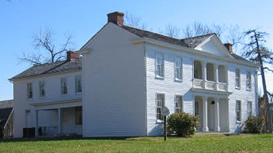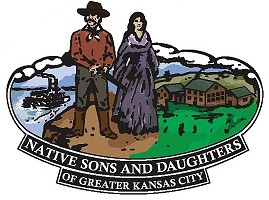Alexander Majors House
The Native Sons and Daughters and the Alexander Majors House The Native Sons and Daughters has a standing committee to work with the Alexander Majors Historical Foundation and its primary holding, the Alexander Majors House and grounds. This organization is run under a trusteeship by Mr. Terry Chapman, an architect based in greater Kansas City. The trusteeship was established through the will of Louisa Poteet Johnston, great granddaughter of Alexander Majors. Louisa owned the Majors House at her death in 1979. Alexander Majors was born in Kentucky in 1814. His family moved to the Odessa, Missouri area when Majors was five. Majors had great personal industry and worked at his father’s mill on the Sni-Bar Creek and for a time lived north of Lake City Arsenal and in Independence. His father was an ironsmith in Independence, and a miller. Majors built a house on South Pleasant Street in Independence, Missouri, opposite Canon Hill, now known as the Campus for the Community of Christ Church (formerly the Reorganized Church of the Latter Day Saints). At one point, Majors lived in southern Cass County and built a cabin there. The western territories and surrounding areas began to offer business opportunities that required insight, cleverness, and a lot of hard work. Trade was good up the Kaw River and he took one of the first wagon trains to sell and trade with the Indians. He returned in 1846 with pelts and jewelry. Majors was sharpening his skills to enable travel along the rapidly developing Santa Fe Trail. He achieved notoriety as a wagon-master and boss, crafting the techniques of business management that demanded sobriety on and off the job, a defined contractual relationship with his men that forbade fighting or gainful employment on Sunday, and the presentation of a Bible, at his cost, to each employee at the start of their signed agreement. Infractions of this contract were cause for dismissal of the employee without receiving their compensation. In addition, Mr. Majors was one of the first to use oxen to pull trail wagons and developed a schooner wagon to help prevent cargo shifting and loss. Over 4000 freight wagons traveled the Santa Fe Trail from the Kansas City area, many part of the Majors' overland business ventures. The Alexander Majors House on State Line and 83rd Street is situated on land that was purchased from the Russell, Majors, and Waddell Freighting Company. The surrounding grounds are a collection of properties acquired in the 1960s and 1970s from a variety of homeowners and property agents who donated, sold and arranged for transfer to the Kansas City Parks and Recreation Department through an agreement worked out with Louisa. The Native Sons and Daughters of Greater Kansas City was instrumental in the purchase and transfer of the property title for the purpose of creating a park to surround her beloved home, in addition to other benefactors who contributed large sums of money to realize her dream. Her idea was to create a site dedicated to the memory and recognition of Mr. Majors and the company he founded 150 years ago. It was for the education of the community and for cultural development as an asset to the historical fabric of Kansas City. In subsequent decades much of the initial promise faded. Docents and volunteers passed away or lost the vitality and momentum to succeed. Attendance suffered, with 1997 being the last profitable year. Recently Mr. Chapman, the trustee, introduced a renewed effort and promise to name board members and appoint a manager to reintroduce the property to the public to fulfill the specific directions of Miss Johnston. The Native Sons and Daughters looks forward to being a part of that plan to introduce and display this extraordinary representation of pre-Civil War culture to the community at large, and preserve a heritage and history of an exciting, iconic pioneer. Look for this historical treasure to be available to you to visit and be part of its anticipated reopening! Expect to see its benefits for your children to learn and develop an appreciation for this time period. We are excited by this new promise. — Lee Pickering, Chair |

 Most recently, the Alexander Majors House site opened for touring on Saturday and Sunday, from 1:00 p.m. to 4:00 p.m. The cost is $5.00 for adults and children, $3.00. The Native Sons and Daughters congratulates Terry Chapman, trustee, for the strides he has taken to present this splendid icon, and for his devotion to its upkeep and adherence to historic tradition.
Most recently, the Alexander Majors House site opened for touring on Saturday and Sunday, from 1:00 p.m. to 4:00 p.m. The cost is $5.00 for adults and children, $3.00. The Native Sons and Daughters congratulates Terry Chapman, trustee, for the strides he has taken to present this splendid icon, and for his devotion to its upkeep and adherence to historic tradition.
 The Native Sons and Daughters of Greater Kansas City
The Native Sons and Daughters of Greater Kansas City